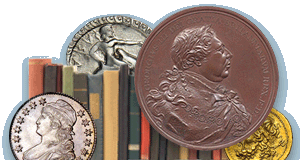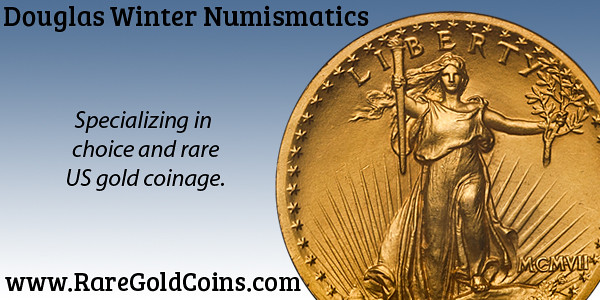
PREV ARTICLE
NEXT ARTICLE
FULL ISSUE
PREV FULL ISSUE
TREASURE TALK WITH BOB EVANS, EPISODE 3.1In January, our good friend Bob Evans began publishing a series of blog articles on the Finest Known website detailing his experience as co-discoverer and curator of the treasures recovered from the wreck of the S.S. Central America. Subject of the book "Ship of Gold", many exhibits, countless interviews and articles, books and auction catalogs feature the legendary haul of gold coins, bars, nuggets, gold dust and more from the 1857 shipwreck. Here's another excerpt - see the complete article online. It's very topical, as it turns out, showing how to provide proper evidence to U.S. Customs inspectors. -Editor The morning of our Customs appointment, Brinks brought out the sturdiest 8-foot folding table they had and placed it in the middle of the locker room, surrounded by the banks of gray, half-height lockers. It looked like a 20-foot section of a public-school hallway, with a table set up for a bake sale. I filled out the paperwork to remove a dozen containers with an assortment of gold coins and ingots, figuring this would be a good start, and maybe all that was needed. Two well-dressed customs agents from the local office arrived for this examination, an athletic-looking, middle-aged black gentleman, and a white woman in a business suit. They reminded me of lawyers rather than cops. They were firm but polite as I showed them an array of gold pieces arranged on the table. The gold was still a fresh catch. While at sea, I had merely stabilized and stored the pieces, maintaining the original conditions as well as I could, swaddled in layers of cloth and plastic, many of the bars were still damp. I offered the visitors exam gloves, like I was wearing, but they thought it unnecessary. The rust from the shipwreck was still in full evidence, coating the gold bars, and flaking off onto the table and onto their hands as they had a close look. I instructed them to handle the coins only by the edges. Since these folks were United States Customs officials, there was one key question: Q: The coins are US gold, but what about the bars? Is this foreign gold? A: No, the ingots were made in California, out of California gold, by firms located in the United States. Q: How do we know that? I phoned our history researchers back at the Home Office in Columbus, so they could fax proof that California became a state in 1850, (not every Virginian knows this off the top of their head,) and copies of ads from the ingot assayers, showing their addresses in San Francisco and Sacramento. While I was arranging for the faxes, the visitors were on the phone with their own office, and before long two more guys from Customs arrived at the door, the local manager, and the regional manager, who happened to be at the Norfolk office that day. This stuff obviously had their attention, and it didn't fit into any standard checkboxes on the forms. They were fingerprinted and ushered into the locker room.
At that time, it was the second largest bar we had recovered, ultimately the fourth largest. This was the biggest brick I set out that morning, and big bricks of gold are not easy to handle. I had plenty of practice by this time. The first move is to tilt the bar and get your fingers under it. Then you grab it firmly, and lift, holding it next to your body with both hands. I placed No. 804 six inches from the table edge, fully supported by a leg directly beneath. For those of you keeping score at home, 662.28 troy ounces is more than 45 pounds, or 20 kilos. And it wasn't the only weight on the folding table. We didn't want it to collapse!
As I remember, the regional manager was a rather large man. Standing on the opposite side of the table, he surveyed the array of messy, rust-covered ingots. Then he reached across and tried to grab No. 804, overhand, with one hand. (In my now long experience, when faced with an assortment of gold bars to ogle, they always go for the biggest one. It's human nature.) When it didn't budge in his grip and his fingers slipped off, he turned beet-red, and he mumbled that I must have glued it to the table. So, I used proper large-gold-bar lifting technique, and I handed it to him, eliciting a grunt as he felt the weight equivalent of a six-year-old child press into his hands. The usual startled reaction:
When the Customs quartet had finished mulling over the gold, it was getting close to lunchtime. Some of the drivers and guards needed to get in their lockers, so traffic was getting busy, and the space was crowded. I offered to send this gold back into the vault and bring more out, but they decided they had seen enough, if we could provide a list of everything recovered. With plenty of smiles and wonder about what they had just seen, as they exited, they remarked with excitement, They never did. At least not to me. Our attorneys told me that apparently there was no issue: American gold, mined in America, brought ashore in another part of America. It just took 132 years. No duties applied.
To read the complete article, see:
For the complete series, see:
To read the earlier E-Sylum article, see:
Wayne Homren, Editor The Numismatic Bibliomania Society is a non-profit organization promoting numismatic literature. See our web site at coinbooks.org. To submit items for publication in The E-Sylum, write to the Editor at this address: whomren@gmail.com To subscribe go to: Subscribe All Rights Reserved. NBS Home Page Contact the NBS webmaster 
|


